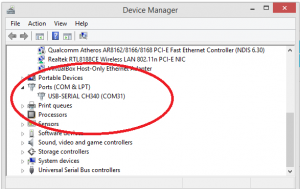

- #Usb ch340 arduino upload how to#
- #Usb ch340 arduino upload install#
- #Usb ch340 arduino upload serial#
- #Usb ch340 arduino upload android#
- #Usb ch340 arduino upload pro#
If you use other serial interface module together with DTR pin, you may not need to perform this step (9).
#Usb ch340 arduino upload pro#
You need to press and hold Reset button on Arduino Pro Mini board during programming because CH340 module does not have DTR output pin.Congratulations, you have successfully programmed the Arduino Pro Mini ! The built-in LED on Arduino Pro Mini board should start blinking by now.ġ0. You’ll notice the LEDs on CH340 module will start flashing for a while, this is indicating the CH340 is uploading program to Arduino Pro Mini. During the upload process, press and hold the Reset button on Arduino Pro Mini, then release it immediately once you see the Arduino IDE passed the compilation process as shown below (full green progress bar and 2 lines of white colored feedback messages). After all the configuration steps, you may upload the Blink program into your Arduino Pro Mini board as a test program by clicking Upload button.ĩ.

You can check if this COM number is same as shown in the Port section of Device Manager.Ĩ. Make sure the COM port in Arduino IDE is selected, at Tools > Port > COMx.
#Usb ch340 arduino upload android#
examples I will use a mobile with Android 9, OTG cable, USB cable and an Arduino UNO with CH340. Before you upload the test program, make sure your Arduino IDE is configured to program the board, at Tools > Board > Arduino Pro or Pro Miniħ. The Arduino Uno comes with a USB-to-serial converter. Or you may type the code below into your Arduino IDE sketch area.Ħ. Open Arduino IDE in your computer, open an example code at File > Examples > 01.Basics > Blink.
#Usb ch340 arduino upload install#
If not, you may manually install the CH340 driver by clicking hereĥ. If you are using Windows OS, make sure that your computer has CH340 driver installed, available at Start Menu > search “device manager” > Device Manager > Ports (COM & LPT). Make sure VCC pin on CH340 module is tied to 3v3 pin beside it. Connect the wires between CH340 module and Arduino Pro Mini as shown.ĬH340 serial module is connected to Arduino Pro Mini and computerĢ.

USB Type-A Data Extension Cable (editor’s optional)Īrduino Pro Mini stacked on mini breadboard so it doesn’t move easily & scratch any surfacesġ.Make sure the I/O pins of Arduino Pro Mini board are soldered with male header pins provided before proceeding.
#Usb ch340 arduino upload how to#
This tutorial will guide you how to program Arduino Pro Mini board with a cheap CH340 USB-to-TTL serial interface module. In any case, are there any examples of getting this working? A sketch or something? I downloaded the latest V-USB release, but I really don't want to make a mistake that will brick or otherwise ruin my device.īasically: I want to just upload my MIDI sketch (with whatever necessary modifications or code) such that I do not need ttymidi to have the device recognized as a MIDI device (over USB) that I can just "plug 'n' play".Ever wondered of shrinking your Arduino control system into minuscule scale? Arduino Pro Mini is introduced to serve this purpose, it can fit into anywhere in your project area where you want to hide it from sight, but it has no built-in serial interface chip like normal Arduino boards do. Dual 3.3V and 5V Power output, work with 3.3v and 5 V target device. TTL interface output, easy to connect to your MCU. Designed to be used for USB to TTL electronic projects. I've read about some solutions which require using an AVR via some of the pins (as opposed to over USB) since you have to reprogram the chip in such a way that it no longer is programmable over USB once the sketch is uploaded, but if I understood it correctly, you can't do even this on the CH340G. CH340G USB To TTL (Serial) Converter For Arduino Nano Raspberry Pi. Or even if this is a solution to my problem. I've been reading up a bit (the amount of information out there is perhaps too vast and often outdated or simply doesn't exactly solve my problem) and have learned of V-USB and the project V-USB-MIDI but I am really out of my element here and do not know how to approach this to get it all working (since it is not just an Arduino sketch and. This article will explain how to prepare your Arduino IDE to upload sketches into the ESP8266 microcontroller and connect to an ESP-12E / ESP-12F board over USB. ESP8266 is a low-cost WiFi-enabled microchip. Not knowing anything, I bought my clone and soon learned about the whole CH340G limitation where it doesn't "just work" (I cannot simply use the USBMIDI Arduino library), and instead I need to run a software MIDI-serial converter command ( ttymidi) in order to send the signals to my Arduino clone. The ESP-12E and ESP-12F are ESP8266 boards. I finally could not resist the urge after going to an Arduino meetup, where someone showed me their Teensy connected to their laptop and reacting to MIDI signals over USB. I just bought my first Arduino compatible device, and I am greatly enjoying it.


 0 kommentar(er)
0 kommentar(er)
